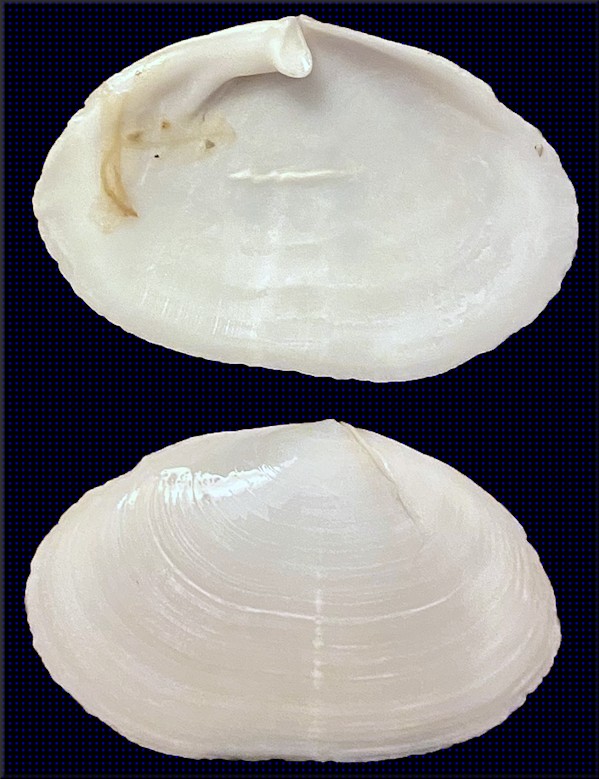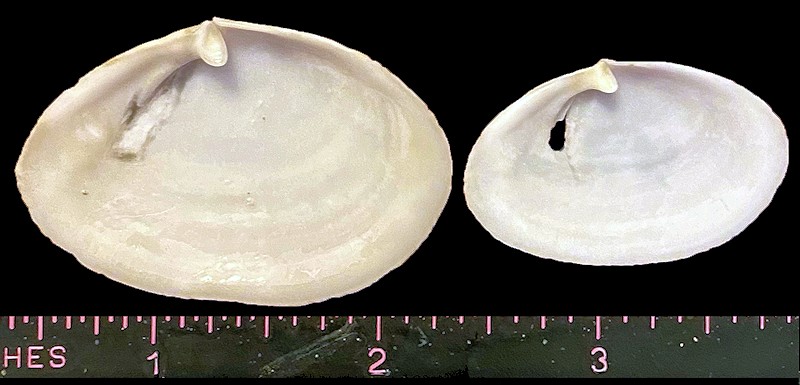|
Cochlodesma antiquum (Conrad, 1834: 130) Antique Spoonclam (Right Valves) |
|
|
|
|
|
Beach, South Hutchinson Island, St. Lucie County, Florida, May, 2022. Digital images by Richard Matteson. |
|
These specimens (41.3 mm. on the
top and 49.3 mm. on the bottom left) surpass the size (1 1/2 inches)
and southern limit of range (North Carolina) provided by Abbott
(1974: 561) for the similar Recent C. leanum (Conrad, 1831:
263, pl. 11, fig. 11 <https://www.biodiversitylibrary.org/page/24677769>).
Even larger specimens have been found nearby. Of interest is (1)
this shoreline was “renourished” with offshore sediments shortly
before the collections, and (2) there is a fossil shell-rich
escarpment just behind this beach. Paleontological analysis of this
latter feature indicates it belongs to the Nashua Formation, of Plio-early
Pleistocene age. The extinct C. antiquum was originally
described from the Pliocene Yorktown Formation, VA and illustrated
four years later (Conrad, 1838: pl. 8, fig. 3
<https://archive.org/details/republicationofc00conr/page/n173/mode/2up>).
It is also represented in the contemporary Jackson Bluff Formation
(Leon Co., FL) by the synonymous C. leanum floridanum
Mansfield, 1937 fide Campbell (1993: 51). Mature specimens of
the two spoonclam species differ in size and shape, but the more
elongate-oval juveniles of the allometric fossil (as
demonstrated above) are almost impossible to distinguish from the
Recent species, which almost certainly its descendant. Perhaps this
process falls under the rubric of neoteny
<https://en.wikipedia.org/wiki/Neoteny>. I don't think this shoreline find is entirely a fluke as I saw a similar specimen collected on a Sanibel, Florida beach and exhibited at the annual shell show on that island a couple of decades ago. Oddly, the exhibitor was underwhelmed by the significance of the sentinel find and the value of shell show displays such as his. Abbott, R.T., 1974. Second Edition American Seashells. Van Nostrand Reinhold, New York. (i)-(ix) + 663 pp. + 24 pls. with 23 facing plate explanations. [vidi] Campbell, L.D., 1993. Pliocene mollusks from the Yorktown and Chowan River Formations in Virginia. Virginia Division of Mineral Resources Publication 127: 1-259. [vidi] Conrad, T.A., 1831. Description of fifteen new species of Recent, and three of fossil shells, chiefly from the coast of the United States Journal of the Academy of Natural Sciences of Philadelphia 6: 256-268, pl. 11 April. <https://www.biodiversitylibrary.org/page/24677674> Conrad, T.A., 1834. Observations on the Tertiary and more recent Formations of a portion of the southern states, [including] appendix. Descriptions of new Tertiary fossils from the southern states. Journal of the Academy of Natural Sciences of Philadelphia 7(1): 116-157. <https://www.biodiversitylibrary.org/page/24676770> Conrad, T.A. (1838–1839) Fossils of the Medial Tertiary of the United States. J. Dobson, Philadelphia. 1, i–xvi, 1–32, + covers with text. [text dated Jan. 1838; inside back cover issued later and dated April 16, 1839] [Reprinted by W.H. Dall, 1893] <https://archive.org/details/republicationofc00conr/page/n5/mode/2up> Mansfield, W.C., 1937. New mollusks of the Choctawhatchee Formation of Florida. Journal of Paleontology 11(7): 608-612 + pl. 85. [vidi] |

